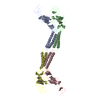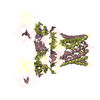[English] 日本語
 Yorodumi
Yorodumi- PDB-4dk1: Crystal Structure of MacA-MexA chimeric protein, containing the P... -
+ Open data
Open data
- Basic information
Basic information
| Entry | Database: PDB / ID: 4dk1 | ||||||
|---|---|---|---|---|---|---|---|
| Title | Crystal Structure of MacA-MexA chimeric protein, containing the Pseudomonas aeruginosa MexA alpha-hairpin domain. | ||||||
 Components Components | Putative MacA, Multidrug resistance protein mexA | ||||||
 Keywords Keywords | MEMBRANE PROTEIN / alpha-hairpin / lipoyl / beta-barrel domains / PERIPLASMIC PROTEIN | ||||||
| Function / homology |  Function and homology information Function and homology informationmacrolide transmembrane transporter complex / xenobiotic detoxification by transmembrane export across the cell outer membrane / efflux pump complex / xenobiotic detoxification by transmembrane export across the plasma membrane / cell envelope / extrinsic component of membrane / efflux transmembrane transporter activity / protein homooligomerization / transmembrane transport / response to antibiotic ...macrolide transmembrane transporter complex / xenobiotic detoxification by transmembrane export across the cell outer membrane / efflux pump complex / xenobiotic detoxification by transmembrane export across the plasma membrane / cell envelope / extrinsic component of membrane / efflux transmembrane transporter activity / protein homooligomerization / transmembrane transport / response to antibiotic / identical protein binding / plasma membrane Similarity search - Function | ||||||
| Biological species |  Aggregatibacter actinomycetemcomitans (bacteria) Aggregatibacter actinomycetemcomitans (bacteria) | ||||||
| Method |  X-RAY DIFFRACTION / X-RAY DIFFRACTION /  SYNCHROTRON / SYNCHROTRON /  MOLECULAR REPLACEMENT / Resolution: 3.499 Å MOLECULAR REPLACEMENT / Resolution: 3.499 Å | ||||||
 Authors Authors | Xu, Y. / Ha, N.C. | ||||||
 Citation Citation |  Journal: J Biol Chem / Year: 2012 Journal: J Biol Chem / Year: 2012Title: Assembly and channel opening of outer membrane protein in tripartite drug efflux pumps of Gram-negative bacteria. Authors: Yongbin Xu / Arne Moeller / So-Young Jun / Minho Le / Bo-Young Yoon / Jin-Sik Kim / Kangseok Lee / Nam-Chul Ha /  Abstract: Gram-negative bacteria are capable of expelling diverse xenobiotic substances from within the cell by use of three-component efflux pumps in which the energy-activated inner membrane transporter is ...Gram-negative bacteria are capable of expelling diverse xenobiotic substances from within the cell by use of three-component efflux pumps in which the energy-activated inner membrane transporter is connected to the outer membrane channel protein via the membrane fusion protein. In this work, we describe the crystal structure of the membrane fusion protein MexA from the Pseudomonas aeruginosa MexAB-OprM pump in the hexameric ring arrangement. Electron microscopy study on the chimeric complex of MexA and the outer membrane protein OprM reveals that MexA makes a tip-to-tip interaction with OprM, which suggests a docking model for MexA and OprM. This docking model agrees well with genetic results and depicts detailed interactions. Opening of the OprM channel is accompanied by the simultaneous exposure of a protein structure resembling a six-bladed cogwheel, which intermeshes with the complementary cogwheel structure in the MexA hexamer. Taken together, we suggest an assembly and channel opening model for the MexAB-OprM pump. This study provides a better understanding of multidrug resistance in Gram-negative bacteria. | ||||||
| History |
|
- Structure visualization
Structure visualization
| Structure viewer | Molecule:  Molmil Molmil Jmol/JSmol Jmol/JSmol |
|---|
- Downloads & links
Downloads & links
- Download
Download
| PDBx/mmCIF format |  4dk1.cif.gz 4dk1.cif.gz | 417.7 KB | Display |  PDBx/mmCIF format PDBx/mmCIF format |
|---|---|---|---|---|
| PDB format |  pdb4dk1.ent.gz pdb4dk1.ent.gz | 337 KB | Display |  PDB format PDB format |
| PDBx/mmJSON format |  4dk1.json.gz 4dk1.json.gz | Tree view |  PDBx/mmJSON format PDBx/mmJSON format | |
| Others |  Other downloads Other downloads |
-Validation report
| Summary document |  4dk1_validation.pdf.gz 4dk1_validation.pdf.gz | 462.5 KB | Display |  wwPDB validaton report wwPDB validaton report |
|---|---|---|---|---|
| Full document |  4dk1_full_validation.pdf.gz 4dk1_full_validation.pdf.gz | 585.9 KB | Display | |
| Data in XML |  4dk1_validation.xml.gz 4dk1_validation.xml.gz | 56.3 KB | Display | |
| Data in CIF |  4dk1_validation.cif.gz 4dk1_validation.cif.gz | 73.3 KB | Display | |
| Arichive directory |  https://data.pdbj.org/pub/pdb/validation_reports/dk/4dk1 https://data.pdbj.org/pub/pdb/validation_reports/dk/4dk1 ftp://data.pdbj.org/pub/pdb/validation_reports/dk/4dk1 ftp://data.pdbj.org/pub/pdb/validation_reports/dk/4dk1 | HTTPS FTP |
-Related structure data
- Links
Links
- Assembly
Assembly
| Deposited unit | 
| ||||||||||||||||||||||||||||||
|---|---|---|---|---|---|---|---|---|---|---|---|---|---|---|---|---|---|---|---|---|---|---|---|---|---|---|---|---|---|---|---|
| 1 | 
| ||||||||||||||||||||||||||||||
| 2 | 
| ||||||||||||||||||||||||||||||
| Unit cell |
| ||||||||||||||||||||||||||||||
| Noncrystallographic symmetry (NCS) | NCS domain:
NCS domain segments:
|
- Components
Components
| #1: Protein | Mass: 36843.281 Da / Num. of mol.: 4 / Fragment: UNP RESIDUES 30-88, 95-158, 181-394 Source method: isolated from a genetically manipulated source Details: The chimeric protein of MacA (RESIDUES 30-88), mexA (RESIDUES 95-158), and MacA (RESIDUES 181-394) Source: (gene. exp.)  Aggregatibacter actinomycetemcomitans (bacteria), (gene. exp.) Aggregatibacter actinomycetemcomitans (bacteria), (gene. exp.)  Strain: PAO1 / Gene: mexA, PA0425 / Production host:  Has protein modification | Y | Sequence details | THESE RESIDUES DERIVE FROM A VARIANT OF THE STRAIN OF THE BACTERIA | |
|---|
-Experimental details
-Experiment
| Experiment | Method:  X-RAY DIFFRACTION / Number of used crystals: 1 X-RAY DIFFRACTION / Number of used crystals: 1 |
|---|
- Sample preparation
Sample preparation
| Crystal | Density Matthews: 4.89 Å3/Da / Density % sol: 74.85 % |
|---|---|
| Crystal grow | Temperature: 287 K / Method: evaporation / pH: 7.5 Details: 0.16M CaCl2, 0.1M Hepes (pH 7.5) 23.5% PEG 400, EVAPORATION, temperature 287K |
-Data collection
| Diffraction | Mean temperature: 100 K |
|---|---|
| Diffraction source | Source:  SYNCHROTRON / Site: SYNCHROTRON / Site:  Photon Factory Photon Factory  / Beamline: AR-NE3A / Wavelength: 1 Å / Beamline: AR-NE3A / Wavelength: 1 Å |
| Detector | Type: ADSC QUANTUM 270 / Detector: CCD / Date: Oct 10, 2011 |
| Radiation | Monochromator: Double mirror / Protocol: SINGLE WAVELENGTH / Monochromatic (M) / Laue (L): M / Scattering type: x-ray |
| Radiation wavelength | Wavelength: 1 Å / Relative weight: 1 |
| Reflection | Resolution: 3.499→20 Å / Num. all: 36819 / Num. obs: 33690 / % possible obs: 91.5 % / Observed criterion σ(F): 0 / Observed criterion σ(I): 0 |
| Reflection shell | Resolution: 3.5→3.56 Å / % possible all: 95 |
- Processing
Processing
| Software |
| ||||||||||||||||||||||||||||||||||||||||||||||||||||||||||||||||||||||||||||||
|---|---|---|---|---|---|---|---|---|---|---|---|---|---|---|---|---|---|---|---|---|---|---|---|---|---|---|---|---|---|---|---|---|---|---|---|---|---|---|---|---|---|---|---|---|---|---|---|---|---|---|---|---|---|---|---|---|---|---|---|---|---|---|---|---|---|---|---|---|---|---|---|---|---|---|---|---|---|---|---|
| Refinement | Method to determine structure:  MOLECULAR REPLACEMENT / Resolution: 3.499→19.951 Å / SU ML: 1.47 / σ(F): 1.68 / Phase error: 34.93 / Stereochemistry target values: ML MOLECULAR REPLACEMENT / Resolution: 3.499→19.951 Å / SU ML: 1.47 / σ(F): 1.68 / Phase error: 34.93 / Stereochemistry target values: ML
| ||||||||||||||||||||||||||||||||||||||||||||||||||||||||||||||||||||||||||||||
| Solvent computation | Shrinkage radii: 0.47 Å / VDW probe radii: 0.8 Å / Solvent model: FLAT BULK SOLVENT MODEL / Bsol: 0 Å2 / ksol: 0.129 e/Å3 | ||||||||||||||||||||||||||||||||||||||||||||||||||||||||||||||||||||||||||||||
| Displacement parameters |
| ||||||||||||||||||||||||||||||||||||||||||||||||||||||||||||||||||||||||||||||
| Refinement step | Cycle: LAST / Resolution: 3.499→19.951 Å
| ||||||||||||||||||||||||||||||||||||||||||||||||||||||||||||||||||||||||||||||
| Refine LS restraints |
| ||||||||||||||||||||||||||||||||||||||||||||||||||||||||||||||||||||||||||||||
| Refine LS restraints NCS |
| ||||||||||||||||||||||||||||||||||||||||||||||||||||||||||||||||||||||||||||||
| LS refinement shell | Refine-ID: X-RAY DIFFRACTION / Total num. of bins used: 12
| ||||||||||||||||||||||||||||||||||||||||||||||||||||||||||||||||||||||||||||||
| Refinement TLS params. | Method: refined / Origin x: -21.0638 Å / Origin y: 78.0611 Å / Origin z: 137.541 Å
| ||||||||||||||||||||||||||||||||||||||||||||||||||||||||||||||||||||||||||||||
| Refinement TLS group | Selection details: ALL |
 Movie
Movie Controller
Controller










 PDBj
PDBj




